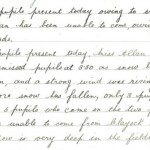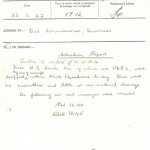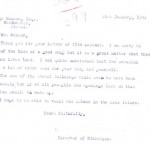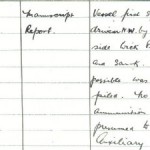Japanese forces continued their advance across the Far East this week: on 19 January they captured large numbers of British troops north of Singapore, and they ended the week by invading the Solomon Islands. On 20 January the infamous Wannsee Conference was held in Berlin, where it was agreed that the “final solution of the Jewish problem” would be extermination. On 21 January the to-and-fro in North Africa resumed when Rommel, reinforced with fresh troops and tanks, launched a surprise offensive, driving the British back. And on 22 January the Soviets began to evacuate thousands of people from the besieged city of Leningrad.
 Caithness experienced its first bad snowstorm of the year, with the north of the county particularly badly affected. The log book for Stemster School tells the story. On 20 January the Head Teacher wrote, “11 pupils present today owing to snowstorm.” The next day, “Dismissed pupils at 3.30 as snow began to fall then, and a strong wind was rising.” Finally, on 22 January, “More snow has fallen, only 3 pupils present. The 5 pupils who came on the two previous days are unable to come from Clayock District, as the snow is very deep in the fields.”
Caithness experienced its first bad snowstorm of the year, with the north of the county particularly badly affected. The log book for Stemster School tells the story. On 20 January the Head Teacher wrote, “11 pupils present today owing to snowstorm.” The next day, “Dismissed pupils at 3.30 as snow began to fall then, and a strong wind was rising.” Finally, on 22 January, “More snow has fallen, only 3 pupils present. The 5 pupils who came on the two previous days are unable to come from Clayock District, as the snow is very deep in the fields.”
With the Luftwaffe committed to the Russian campaign, Caithness had seen relatively little air activity in recent
months. However on 23 January this changed dramatically, as the following message from Wick A.R.P. Control shows: “Further to report of 14.10 hours. Three H.E. [high explosive] bombs, two of which are UXB’s [unexploded bombs], were dropped by enemy aircraft within Wick Aerodrome today. There were no casualties and little or no material damage”.
 This explains the following entry in Ackergill School log book for the same day, as Ackergill lies almost adjacent to Wick airport runway: “This afternoon we spent nearly an hour in the [air raid] shelter. The children were dismissed after the “All Clear”.”
This explains the following entry in Ackergill School log book for the same day, as Ackergill lies almost adjacent to Wick airport runway: “This afternoon we spent nearly an hour in the [air raid] shelter. The children were dismissed after the “All Clear”.”
Last week the SS Empire Parson ran aground on the island of Stroma and all the crew were saved. This week the Director of Education wrote to the Headmaster of Stroma School regarding the use of the school to take in the survivors: “I am sorry to hear of the loss of a good ship but it is a great matter that there were no lives lost. I quite understand that the occasion meant a lot of extra work for your good lady and yourself. The use of the school buildings would seem to have been a necessity but if at all possible the openings lost on this occasion should be made up.”
saved. This week the Director of Education wrote to the Headmaster of Stroma School regarding the use of the school to take in the survivors: “I am sorry to hear of the loss of a good ship but it is a great matter that there were no lives lost. I quite understand that the occasion meant a lot of extra work for your good lady and yourself. The use of the school buildings would seem to have been a necessity but if at all possible the openings lost on this occasion should be made up.”
 Finally this week there was another shipwreck, and one with a much sadder outcome. SS Isleford was a small coaster on its way from Lyness to Invergordon. The entry in the Receiver of Wrecks log book tells the story: “Vessel first sighted at Sarclet & was being driven N.W. by hurricane. Struck north side Wick Bay (inside Proudfoot Point) and sank. Only rescue attempt possible was to put rocket line about. This failed. No survivors. Vessel carried ammunition cases, mines etc. – was presumed to be SS Isleford, a Fleet Auxiliary vessel.”
Finally this week there was another shipwreck, and one with a much sadder outcome. SS Isleford was a small coaster on its way from Lyness to Invergordon. The entry in the Receiver of Wrecks log book tells the story: “Vessel first sighted at Sarclet & was being driven N.W. by hurricane. Struck north side Wick Bay (inside Proudfoot Point) and sank. Only rescue attempt possible was to put rocket line about. This failed. No survivors. Vessel carried ammunition cases, mines etc. – was presumed to be SS Isleford, a Fleet Auxiliary vessel.”
It appears that concerns grew down the years that divers might try to reach the wreck, which would be potentially dangerous because of the contents. So in the summer of 1992 the Royal Navy mounted an operation to remove as much of the ordnance as they could find, though because the ship had broken up it was not possible to reclaim all of it.
